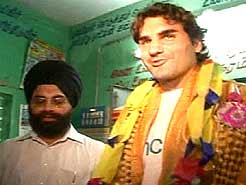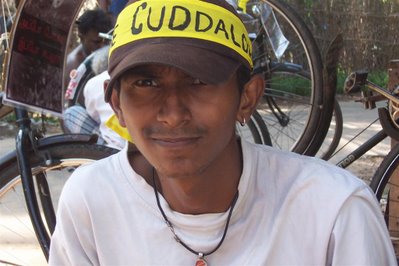Goodwill Ambassador Roger Federer sees tsunami recovery progress in Tamil Nadu -
UNICEFCUDDALORE, India, 22 December 2006 – Just days before the second anniversary of the Indian Ocean tsunami, tennis great and UNICEF Goodwill Ambassador Roger Federer visited Tamil Nadu, India, witnessing firsthand the progress made to help tsunami-affected communities ‘build back better’.
 UNICEF Goodwill Ambassador Roger Federer meets children and staff at the Government Home for Tsunami-Affected Children in the city of Cuddalore, Tamil Nadu, India.
UNICEF Goodwill Ambassador Roger Federer meets children and staff at the Government Home for Tsunami-Affected Children in the city of Cuddalore, Tamil Nadu, India.The tsunami killed some 8,000 people in Tamil Nadu alone, destroyed nearly 200 schools and damaged more than 350 child care centres. On his first field trip since becoming a Goodwill Ambassador, Mr. Federer toured UNICEF-supported recovery and rehabilitation programmes in Cuddalore, a district devastated by the tsunami.
He met with many schoolchildren who, for the first time, have chairs and tables in their classrooms. As part of the recovery effort, new furniture and learning materials have been provided to 330 schools, benefiting some 40,000 children and 3,500 teachers.
‘Bouncing back’Apart from the improved leaning environment, Mr. Federer also saw new ‘child-friendly’ learning and teaching methods being introduced in the schools.
Another post-tsunami initiative here – psycho-social support for traumatized children – has reached more than 114,000 children through counselling, art, puppetry and children’s theatre.
 At Thazanguda Government School in Tamil Nadu, UNICEF Goodwill Ambassador Roger Federer signs autographs.
At Thazanguda Government School in Tamil Nadu, UNICEF Goodwill Ambassador Roger Federer signs autographs.“It’s amazing to see how young people are using the rebuilding process as an opportunity to improve their lives and strengthen their community,” said Mr. Federer. “The way these children are bouncing back from even the toughest tragedy is a testament to their resiliency.”
Ms. Federer went on to visit an early childhood centre, one of the 351 such facilities rehabilitated with UNICEF’s support. The centre is equipped to provide young children with education, nutritious meals and basic health care.
Along with District Collector Gagandeep Singh Bedi, Mr. Federer also met with the children in the Cuddalore Orphanage. UNICEF has helped establish a tracking system to monitor and protect some 2,000 children, including those in the orphanage, who lost one or both of their parents in the tsunami.
Education and child protection“Our focus has been to improve equity to services and to truly build back better for the children of Tamil Nadu,” said UNICEF’s State Representative in Tamil Nadu, Thomas George. “Many of the programmes we set up in the tsunami-hit communities, such as education programmes and child protection interventions, will now serve as a model for the rest of the state to follow.”
Mr. Federer’s first day in Tamil Nadu ended with him meeting young people at a life skills workshop, which offered practical information to help them make responsible decisions – such as better protecting themselves from HIV/AIDS and educating others about the disease.
“It’s great to see the young people so full of life and spirit,” remarked Mr. Federer. “Despite what happened to their community, they have really managed to turn things around.”
 Two weeks back former US President Bill Clinton, who visited Cuddalore as a UN special envoy for tsunami relief, greatly applauded the active steps taken by our district administrator Mr. Gagadeep Singh Bedi. India's over all response to the tsunami disaster work was good. But what has happened in Cuddalore in the past two years was excellent. It is because of our dynamic collector Mr. Gagandeep Singh Bedi, Cuddalore has seen such an immense reconstruction in the post disaster period. According to Clinton, providing housing was "the hardest thing to do". He added while in other places only 30% of the houses were built, "In Cuddalore, even those not affected by the tsunami but identified as "vulnerable" had been given houses." He went on to say "Florida can learn from Cuddalore" and that he want Cuddalore model of disaster management to be implemented throughout the world.
Two weeks back former US President Bill Clinton, who visited Cuddalore as a UN special envoy for tsunami relief, greatly applauded the active steps taken by our district administrator Mr. Gagadeep Singh Bedi. India's over all response to the tsunami disaster work was good. But what has happened in Cuddalore in the past two years was excellent. It is because of our dynamic collector Mr. Gagandeep Singh Bedi, Cuddalore has seen such an immense reconstruction in the post disaster period. According to Clinton, providing housing was "the hardest thing to do". He added while in other places only 30% of the houses were built, "In Cuddalore, even those not affected by the tsunami but identified as "vulnerable" had been given houses." He went on to say "Florida can learn from Cuddalore" and that he want Cuddalore model of disaster management to be implemented throughout the world.



























